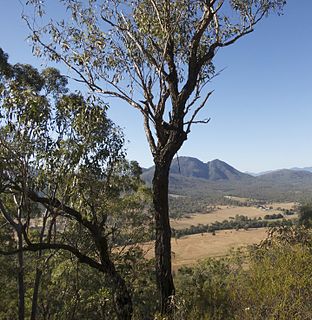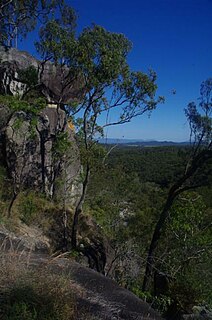
Eucalyptus caleyi, commonly known as Caley's ironbark or Ovenden's ironbark is a species of small to medium-sized tree, endemic to eastern Australia. It has brown or black "ironbark" on the trunk and main branches, dull bluish grey lance-shaped to egg-shaped adult leaves, flower buds in groups of seven, white flowers and barrel-shaped or conical fruit. It grows on the Central and Northern Tablelands of New South Wales and in south-eastern Queensland.

Eucalyptus dura is a species of small to medium sized tree that is endemic to south-eastern Queensland. It has rough, dark grey to black "ironbark", lance-shaped adult leaves, flower buds in groups of seven, white flowers and conical fruit.
Eucalyptus fracta is a species of tree or mallee that is endemic to a small area of New South Wales. It has hard, grey to black "ironbark" on the trunk and larger branches, smooth whitish bark above, lance-shaped adult leaves, flower buds in groups of seven, and cup-shaped fruit.

Eucalyptus prava, commonly known as orange gum, is a species of small to medium-sized tree that is endemic to eastern Australia. It has smooth, mottled bark, lance-shaped or curved adult leaves, flower buds in groups of seven, white flowers and cup-shaped or hemispherical fruit.
Corymbia clandestina, commonly known as the Drummond Range bloodwood, is a species of small tree that is endemic to Queensland. It has rough, tessellated bark on the trunk and branches, lance-shaped adult leaves, flower buds in groups of seven, white flowers and urn-shaped to barrel-shaped fruit.
Eucalyptus atrata, commonly known as the Herberton ironbark or blue-leaved ironbark, is a small tree that is endemic to Queensland. It has hard, black "ironbark" on the trunk and all but the thinnest branches, lance-shaped adult leaves, buds usually arranged in groups of seven, white flowers and cup-shaped to hemispherical fruit. It is characterised by the blue-grey, powdery bloom on its leaves and flower buds.
Eucalyptus corynodes is a species of tree that is endemic to Queensland. It has hard, dark grey "ironbark", lance-shaped to curved adult leaves, flower buds usually on a branching inflorescence, the buds in groups of seven, white flowers and barrel-shaped to cup-shaped fruit.
Eucalyptus decolor is a species of small to medium-sized tree that is endemic to Queensland. It has rough, hard, fissured "ironbark", lance-shaped to curved adult leaves that are distinctly paler on the lower surface, flower buds in groups of seven, white flowers and hemispherical to cup-shaped fruit.

Eucalyptus decorticans, commonly known as the gum-top ironbark, is a species of tree that is endemic to Queensland. It has rough, dark grey or black "ironbark" on the trunk and larger branches, smooth white bark on the thinner branches, lance-shaped to curved adult leaves, flower buds in groups of seven, white flowers and conical, cup-shaped or barrel-shaped fruit.

Eucalyptus granitica, commonly known as the granite ironbark, is a species of tree that is endemic to Queensland. It has dark grey or black "ironbark" on the trunk and branches, glossy green, lance-shaped to curved adult leaves, flower buds in groups of seven, white flowers and cup-shaped to barrel-shaped fruit.
Eucalyptus melanoleuca, commonly known as yarraman ironbark or nanango ironbark, is a species of tree that is endemic to south-east Queensland. It has rough ironbark on the trunk and larger branches, smooth bark above, lance-shaped adult leaves, flower buds in groups of seven, white flowers and barrel-shaped, to cup-shaped or conical fruit.
Eucalyptus paedoglauca, commonly known as the Mount Stuart ironbark, is a small to medium-sized tree that is endemic to a small area in Queensland. It has rough, dark ironbark, lance-shaped adult leaves, flower buds in groups of seven, white flowers and cup-shaped fruit. It is only known from a few hills near Townsville.
Eucalyptus persistens is a species of small tree that is endemic to Queensland. It has rough, dark grey bark, lance-shaped adult leaves, flower buds in groups of seven, white flowers and cup-shaped or barrel-shaped fruit.

Eucalyptus quadricostata, commonly known as the square-fruited ironbark, is a species of small to medium-sized ironbark that is endemic to Queensland. It has rough ironbark on the trunk and branches, lance-shaped to curved adult leaves, flower buds in groups of seven, white flowers and cup-shaped fruit that are square in cross-section.

Eucalyptus rhombica is a small to medium-sized tree that is endemic to a small area of south-east Queensland. It has rough, ironbark on the trunk and larger branches, smooth bark above, lance-shaped adult leaves, flower buds in groups of seven, white flowers and cup-shaped or conical fruit.
Eucalyptus sicilifolia is a species of small ironbark tree that is endemic to Queensland. It has dark ironbark on the trunk and branches, narrow lance-shaped to curved adult leaves, flower buds in groups of seven, white flowers and cup-shaped to barrel-shaped fruit.
Eucalyptus suffulgens is a small to medium-sized tree that is endemic to Queensland. It has hard ironbark on the trunk and larger branches, smooth bark above, lance-shaped adult leaves, flower buds in groups of seven on the ends of branchlets, white flowers and barrel-shaped fruit.
Eucalyptus tholiformis is a species of tree that is endemic to a small area in Queensland. It has rough, deeply furrowed iron bark on the trunk and larger branches, lance-shaped adult leaves, flower buds in groups of seven, white flowers and cup-shaped to funnel-shaped fruit.

Eucalyptus virens, commonly known as the shiny-leaved ironbark, is a species of small to medium-sized tree that is endemic to Queensland. It has hard ironbark on the trunk and branches, narrow lance-shaped adult leaves, flower buds in groups of seven, white flowers and hemispherical fruit.
Eucalyptus farinosa is a species of small tree that is endemic to Queensland. It has hard, dark grey ironbark, egg-shaped to lance-shaped adult leaves, flower buds in groups of seven, white flowers and cup-shaped to barrel-shaped and ribbed fruit.










